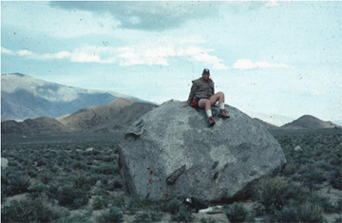|
Alluvial fans archive the interaction between surface materials and the hydrologic cycle. Bierman and several students have worked both in humid northeastern and arid southwestern North America attempting to read the geologic records these fans preserve. In California we have used 10-Be to date surface boulders delivered from the Sierra Nevada Mountains by debris flows to fans in the Owens Valley. Much of this delivery occurred during periods of glaciation and deglaciation when the climate was wetter and less stable. In Vermont, we have trenched and studied alluvial fans sediments that were deposited after the glaciers left New England 14,000 years ago. We find that fan deposition and soil formation occurred episodically throughout the Holocene perhaps driven by changes in storminess and effective soil moisture. The greatest impact to hillslopes and the fans below was colonial and post-colonial clear-cutting, which catalyzed massive hillslope erosion and rapid, widespread fan sedimentation.
Relevant Publications:
- Jennings, K., Bierman, P., and Southon, J. (2003) Timing and style of deposition on humid-temperate fans, Vermont, U.S.A., Geological Society of America Bulletin, v. 115, n.2, p.182–199.
- Zehfuss, P. H, Bierman, P.R., Gillespie, A. R., Burke, R. M., and Caffee, M.W. (2001) Slip rates on the Fish Springs fault, Owens Valley, California deduced from cosmogenic 10Be and 26Al and relative weathering of fan surfaces. Geological Society of America Bulletin. v. 113 (2), p. 241-255.
- Bierman, P., Gillespie, A., Caffee, M. (1995) Cosmogenic Ages for Earthquake Recurrence Intervals and Debris-Flow Fan Deposition, Owens Valley, CA. Science, 270, 447-450.
- Bierman, P., Lini, A., Davis, P.T., Southon, J., Baldwin, L., Church, A. and Zehfuss, P. (1997) Post-glacial ponds and alluvial fans: recorders of Holocene landscape history. GSA Today, 7 (10) p. 1-8.
|




